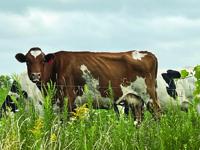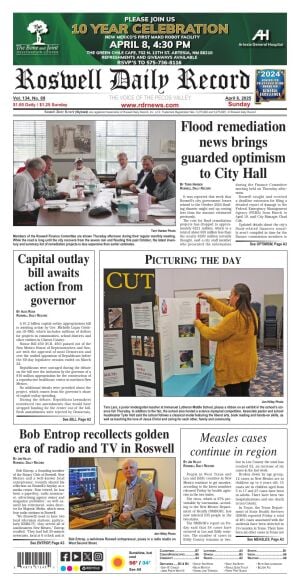DE FOREST, Wisconsin — Farmers need a tool kit to improve sustainability in animal agriculture because methane from livestock is often targeted by those concerned about global warming and climate change. Farmers need to have practices and facts in hand to counter allegations thrown at them.
Frank Mitloehner, an air quality specialist and professor at the University of California-Davis, has been focusing on livestock and climate for many years and notes that methane is an “Achilles heel” for animal agriculture. He has been countering false information aimed at livestock and animal agriculture for decades. Social media has made that job even more important.
“Millions of people are interested in these topics and these topics will not go away. They are especially important to teens and 20-somethings,” Mitloehner said at a recent watershed conference sponsored by Yahara Pride Farms, a farmer-led group in southern Wisconsin aimed at reducing phosphorus.
Yahara Pride Farms organizers said they have tried to get Mitloehner as a keynote speaker for three years for their well-attended watershed conference and this year they were successful.
Explaining the truth about greenhouse gases
Mitloehner went back to basics and explained to the farmers in attendance that without a certain amount of greenhouse gas, life on Earth would not be possible. The blanket of gases in Earth’s atmosphere keeps heat from escaping and protects life from solar radiation. But that blanket has gotten too thick since humans started mining coal and petroleum and burning it as fuel.
“But all greenhouse gas is not the same,” Mitloehner said. “Farmers are often blamed for carbon dioxide (CO2) or methane (CH4) emissions that contribute to global warming.”
Mitloehner maintains United Nations estimates include U.S. farmers’ emissions along with those from other countries — and they are not the same.
The U.N. agencies maintain that 11 percent of greenhouse gasses (GHG) stem from livestock globally, but in the United States livestock production is different. The U.S. Environmental Protection Agency (EPA) finds that U.S. livestock contribute 4 percent of the GHG. Mitloehner said that both animal and plant sectors of agriculture have to do their part.
Mitloehner said that GHG is classified into “global warming potential” (GWP) with CO2 having a score of 1 and methane scoring 28.
“It’s much more potent than CO2,” he said. However methane is produced and also destroyed pretty quickly. “It has a very short life span. Carbon dioxide can be in the atmosphere for 1,000 years while methane is generally in the atmosphere for 12 years.”
“This is not a small, little nuance. It’s critically important,” Mitloehner said. “I’m not saying we should ignore methane. If we manage it, we can be a major part of an important solution.”
Professor says cows vs. cars is a false
comparison
The media and people on social media, which Mitloehner spends a lot of time trying to correct, act like methane is a stock gas like CO2. “If you think of a bathtub filling with water, carbon dioxide has a faucet and no drain. The same is not true for methane. It has a faucet and a drain.”
In agriculture, there is a carbon cycle that includes photosynthesis where plants turn carbon into carbohydrates and when animals eats those plants some of the carbon converts into methane. Belching in cattle is the top source of CH4 but it’s important to remember that it came from the atmosphere.
“Within 10 years it goes back to the atmosphere as CO2,” he said. Because it is a cycle, livestock agriculture is not adding carbon to the atmosphere. Oil, coal and gas were all once animals that were fossilized over 100-200 million years ago and it accumulated underground. For the last 70 years, people have extracted it, burned it for energy and let that stored carbon accumulate in the atmosphere.
“The comparison of cows versus cars is a false comparison,” Mitloehner said.
We are not farming like our grandparents did
Mitloehner told the Yahara Pride farmers that reducing phosphorus in runoff from their farms is also helping to keep carbon in the ground. On the livestock side, any reduction of emissions is a win for the environment.
“We should not lose and waste methane, because it is energy. Ten to 12 percent of the energy fed to ruminant animals is wasted in belching,” he said.
Drumbeat calling for plant-based diets won’t stop if public doesn’t understand what farmers are doing
Much of the media attention these days involves encouraging people to eat less meat, but he feels that it’s important for farmers to point out that they are not farming like their grandparents did. Mitloehner said he asks animal agriculture opponents to think about the fuel efficiency of their cars and compare that to those driven in earlier generations.
Right now there are about 9 million dairy cows in the U.S.; there are 300 million in India. “India and Brazil have more cows than all the rest of the world,” Mitloehner added.
The U.C. Davis professor notes that grass and its component cellulose is the most abundant biomass produced in the world. The Earth has a finite amount of arable land that can be used to produce food — ruminants can take that biomass and turn it into food that people can eat. He disagrees with those who advocate for plant-based diets because that huge global amount of cellulose that is transformed into food by ruminants would be left out of the equation. And much of the land that supports grass growth could not be used to grow other things that people eat.
Farmers have been able to increase the productivity of their livestock through better animal health, breeding and feeding. “U.S. farmers are world champions of these improvements,” he said.
Mitloehner said this drumbeat calling for plant-based diets for people won’t stop because the public doesn’t understand what farmers are doing. “I make it my job to tell them what farmers are doing,” he said. “We need discussion that’s fact-based and of interest to people. Some will never be convinced. Never wrestle with a pig — you’ll both get dirty and the pig with like it.”
Farmers are already reducing methane emissions
California’s dairy industry includes about 20 percent of the U.S. dairy cattle. A 1,500-cow dairy is the average and 3,000 to 5,000 cows per farm are not unusual in some regions of the state, he said. The state of California has set aggressive targets for its dairy farmers to meet to reduce methane emissions by 2030 and the year 2013 has been set up as the threshold for comparison.
What the state found was that the state’s farmers had been reducing methane emissions by more than the required amount for years. Cows have become biologically more efficient year by year and farmers have been using covers on their lagoons to collect methane so it can be piped to a gas system and used for renewable natural gas to power vehicles.
Farmers are also using feed additives to reduce the amount of methane produced by cows. These include new commercial products, seaweed, fatty acids, monensin and even oregano.
“This is very important technology to get us to where we want to go. They can have a 15-times return on investment,” he said.
Farmers can also advance the goal of reducing emissions by genetic selection of “low-methane” animals and tests are beginning to determine which animals those are.
“I am encouraged to see less of a ‘we-vs.-them’ approach and rather an attitude of ‘let’s work together to solve the problem’,” he said.
In his native Germany, as well as Netherlands and Belgium, governments have been engaged in buyouts of farmers but Mitloehner said he thinks a partnership like what is happening in California is a better one.
“We are the global envy for how we produce livestock.”
He doesn’t believe sustainability is only a left-wing concern but needs to be part of farmers’ thought process. He thinks of sustainability as synonymous with “stewardship.” The five pillars of sustainability should include environmental, animal health, food safety and quality, workers and financial viability — because without that the farming operation is not “sustainable.”
Mitloehner said that as someone who doesn’t work for the federal government, he is concerned about the staff and budget cuts happening in Washington, D.C. Cuts to many of the programs at agencies like the Natural Resources Conservation Service are “important to keep you doing what you’re doing,” he told farmers.









